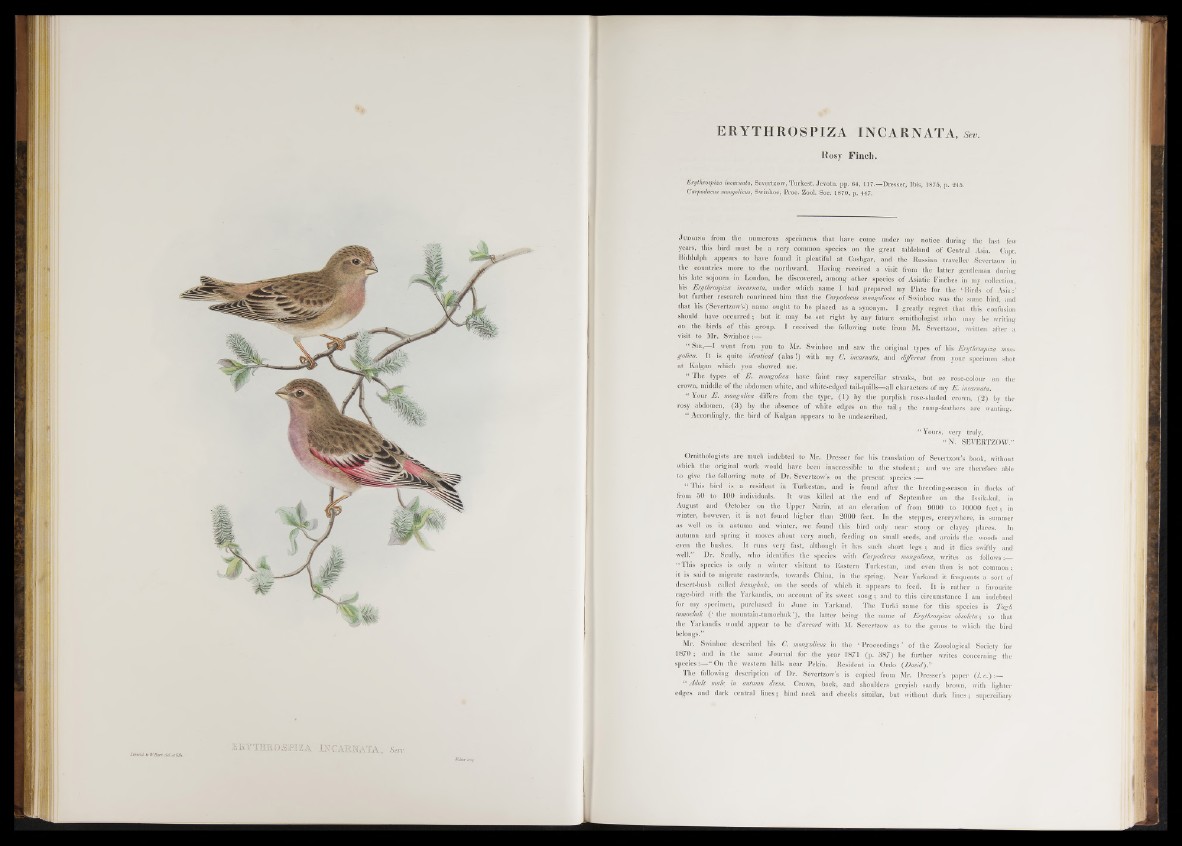
K T H R O S J P I Z A I R C A S B A X & . , Serr.
ERYTHROSPIZA INCARNATA , sev.
Rosy Finch.
Erythrospiza incamata, Severtzow, Turkest. Jevotn. pp. 64, 117.—Dresser, Ibis, 1876, p. 245.
Carpodacus mongolicus, Swinhoe, Proc. Zool. Sbc. 1870, p. 447.
J u dg in g from the numerous specimens that have come under my notice duriny the last few
years, this bird must be a very common species on the great tableland of Central Asia. Capt.
Biddulph appears to have found it plentiful at Cashgar, and the Russian traveller Severtzow in
the countries more to the northward. Having received a visit from the latter gentleman during
his late sojourn in London, he discovered, among other species of Asiatic Finches in my collection,
his Erythrospiza incamata, under which name I had prepared my Plate for the ‘ Birds of Asia;’
but further research convinced him that the Carpodacus mongolicus of Swinhoe was the same bird, and
that his (Severtzow’s) name ought to be placed as a synonym. I greatly regret that this confusion
should have o ccurred; but it may be set right by any future ornithologist who may be writing
on the birds o f this group. I received the following note from M. Severtzow, written after a
visit to Mr. Swinhoe :—
“ S ir ,—I went from you to Mr. Swinhoe and saw the original types of his Erythrospiza mongólica.
It is quite identical (alas!) with my C. incamata, and different from your specimen shot
at Kalgan which you showed me.
“ The types o f E . mongólica have faint rosy superciliar streaks, but no rose-colour on the
crown, middle o f the abdomen white, and white-edged tail-quills—all characters o f my E. incamata.
“ Your E . mongólica differs from the type, (1 ) by the purplish rose-shaded crown, (2 ) by the
rosy abdomen, (3 ) by the absence o f white edges on the t a il; the rump-feathers are wanting.
“ Accordingly, the bird of Kalgan appears to be undescribed.
“ Yours, very truly,
“ N. SEVERTZOW.”
Ornithologists are much indebted to Mr. Dresser for his translation of Severtzow’s book, without
which the original work would have been inaccessible to the student; and we are therefore able
to give the following note of Dr. Severtzow’s on the present species
“ This bird is a resident in Turkestan, and is found after the breeding-season in flocks of
from 50 to 100 individuals. I t was killed a t the end of September on the Issik-kul, in
August and October on the Upper Narin, at au elevation o f from 9000 to 10000 fee t; in
winter, however, it is not found higher than 2000 feet. In the steppes, everywhere! in summer
as well as in autumn and winter, we found this bird only near stony or clayey places. In
autumn and spring it moves about very much, feeding on small seeds, and avoids the. woods and
even the bushes. It runs very fast, although it has such short legs ; and it flies swiftly and
well. Dr. Scully, who identifies the species with Carpodacus mongolicus, writes as follows:—
“ This species is only a winter visitant to Eastern Turkestan, and even then is not common;
it is said to migrate eastwards, towards China, in the spring. Near Yarkand it frequents a sort of
desert-bush called kamghak, on the seeds of which it appears to feed. It is rather a favourite
cage-bird with the Yarkandis, on account o f its sweet so n g ; and to this circumstance I am indebted
for my specimen, purchased in June in Yarkand. The Turki name for this species is Tagh
tumochuk ( ‘ the mountain-tumochuk’), the latter being the name o f Erythrospiza obsoleta; so that
the Yarkandis would appear to be cTaccord with M. Severtzow as to the genus to which the bird
belongs.”
Mr. Swinhoe described his C. mongolicus in the ‘ Proceedings’ o f the Zooological Society for
1 8 7 0 ; and in the same Journal for the year 1871 (p. 387) he further writes concerning the
species:— “ On the western hills near Pekin. Resident in Ordo (David) .”
The following description o f Dr. Severtzow’s is copied from Mr. Dresser’s paper (/. <?.):—
“ Adult male in autumn dress. Crown, back, and shoulders greyish sandy brown, with lighter
edges and dark central lines ; hind neck and cheeks similar, but without dark lin e s ; superciliary